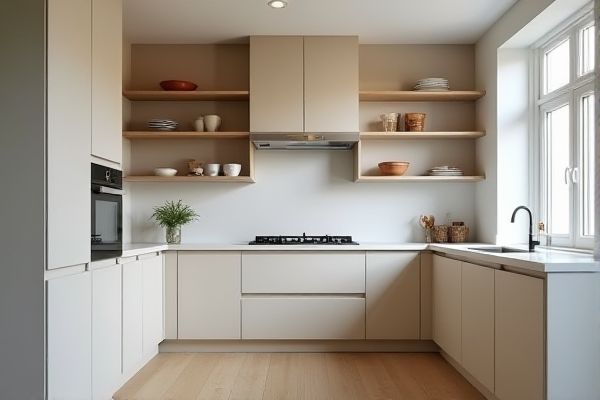
Choosing between upper cabinets and no upper cabinets significantly impacts kitchen storage and design aesthetics, with upper cabinets offering more storage space while a lack of them creates a more open, airy feel. Explore the rest of the article to understand which option best suits Your kitchen needs and lifestyle.
Table of Comparison
| Feature | Upper Cabinets | No Upper Cabinets |
|---|---|---|
| Storage Capacity | High - Additional storage for dishes, food, and kitchenware | Low - Limited to base cabinets and open shelving |
| Visual Space | Reduced - Can make kitchen feel smaller or cluttered | Increased - Creates open, airy, and spacious feel |
| Design Style | Traditional and practical, supports various kitchen designs | Modern and minimalist, emphasizes clean lines |
| Accessibility | Requires reaching higher, may be difficult for some users | Easy access, items stored at lower or eye-level |
| Installation Cost | Higher - Additional cabinetry and mounting costs | Lower - Saves cost on upper cabinetry and hardware |
| Lighting | May need under-cabinet lighting to avoid dark countertops | Better natural and artificial lighting distribution |
| Cleaning & Maintenance | More surface area to clean (cabinets, doors, handles) | Less maintenance, easier to wipe down walls and backsplashes |
Introduction to Upper Cabinets vs No Upper Cabinets
Upper cabinets provide essential vertical storage, maximizing kitchen organization and accessibility by utilizing wall space for dishes, cookware, and pantry items. Opting for no upper cabinets creates an open, airy ambiance that enhances natural light and allows for customizable wall decor or open shelving alternatives. The choice between upper cabinets and no upper cabinets significantly affects kitchen functionality, visual appeal, and storage capacity, influencing design style and user convenience.
Kitchen Design Aesthetics: With or Without Upper Cabinets
Upper cabinets create a classic, structured look in kitchen design, offering ample storage and a visual balance between wall and base elements. Without upper cabinets, kitchens achieve a minimalist, open aesthetic that can make the space feel larger and more modern while encouraging creative alternatives like open shelving or statement backsplashes. Your design choice influences not just storage but also the overall ambiance, light flow, and perceived spatial dimensions of the kitchen.
Storage Capacity: Maximizing Space
Upper cabinets significantly enhance your kitchen's storage capacity by utilizing vertical wall space for dishes, cookware, and pantry items. Without upper cabinets, storage options become limited to lower cabinets and countertops, reducing overall organization potential. Maximizing space relies on integrating upper cabinets to keep essentials accessible while maintaining a clutter-free environment.
Accessibility and Convenience
Upper cabinets provide easy access to frequently used items, keeping kitchen essentials within arm's reach and maximizing vertical storage space. Without upper cabinets, the kitchen feels more open and spacious, but this often means relying on lower cabinets and countertops, which can require more bending and limit storage capacity. Choosing between upper cabinets and no upper cabinets impacts convenience by balancing storage accessibility against a minimalist, open design aesthetic.
Visual Openness and Airiness
Choosing upper cabinets creates more storage but can limit visual openness, making your kitchen feel smaller and less airy. Opting for no upper cabinets enhances airiness, allowing natural light to flow freely and creating a spacious, open environment. Your design choice directly impacts the perception of space and the overall ambiance of the kitchen.
Cost Considerations and Budgeting
Upper cabinets typically increase kitchen remodeling costs by adding material, labor, and installation expenses, often ranging from $500 to $1,500 per linear foot depending on design and materials. Opting for no upper cabinets can reduce initial costs and create a more open, airy space but may require investment in alternative storage solutions like open shelving or additional lower cabinetry. Budgeting should factor in long-term functionality and potential expenses related to customized storage or decorative finishes if upper cabinets are omitted.
Impact on Lighting and Atmosphere
Upper cabinets influence kitchen lighting by casting shadows that can create a cozier, more intimate atmosphere but may require additional under-cabinet lighting to maintain brightness. Removing upper cabinets allows natural and artificial light to spread more evenly, resulting in an open, airy ambiance that enhances spatial perception. The choice affects overall mood and functionality, with upper cabinets favoring a warm, enclosed feel and their absence promoting brightness and openness.
Cleaning and Maintenance Differences
Upper cabinets require regular dusting and cleaning to prevent grease and grime buildup, especially in kitchen environments where splatters are common. In contrast, spaces without upper cabinets simplify maintenance by reducing surface area prone to dust accumulation, making it easier to wipe down countertops and walls. While upper cabinets offer storage, they often demand more frequent attention to keep their exterior surfaces spotless and hygienic.
Resale Value and Market Trends
Homes with upper cabinets often enjoy higher resale values due to increased storage space and enhanced kitchen functionality that appeal to a broad range of buyers. Market trends indicate a growing preference for open shelving or no upper cabinets in modern, minimalist designs, especially in urban and high-end markets seeking sleek aesthetics. Balancing traditional appeal with contemporary trends can optimize resale value by meeting diverse buyer expectations.
Which Option Suits Your Lifestyle?
Upper cabinets maximize kitchen storage by providing ample space for dishes, cookware, and pantry items, ideal for those who value organization and have a busy cooking routine. Opting for no upper cabinets creates an open, airy feel that suits minimalist or modern designs and benefits users who prefer frequent grocery trips over bulk storage. Evaluating your cooking habits, kitchen size, and design preferences will determine if upper cabinets enhance functionality or if their absence better complements a streamlined lifestyle.
 homyna.com
homyna.com